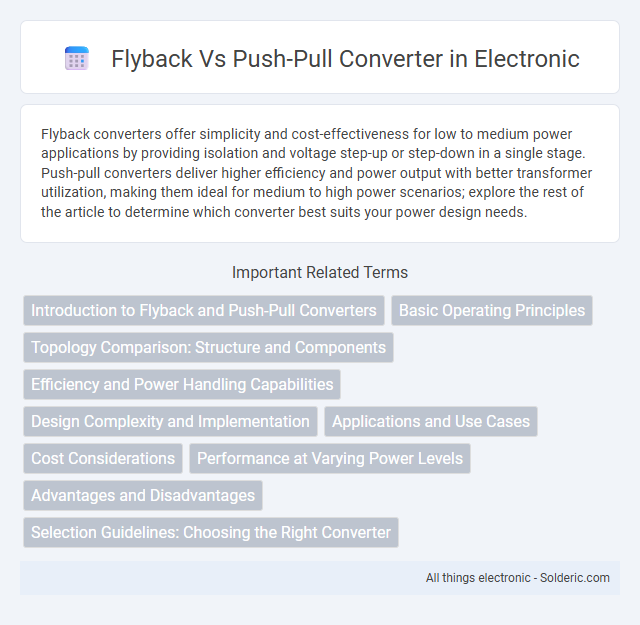Flyback converters offer simplicity and cost-effectiveness for low to medium power applications by providing isolation and voltage step-up or step-down in a single stage. Push-pull converters deliver higher efficiency and power output with better transformer utilization, making them ideal for medium to high power scenarios; explore the rest of the article to determine which converter best suits your power design needs.
Comparison Table
| Feature | Flyback Converter | Push-Pull Converter |
|---|---|---|
| Topology | Single switch with transformer storing energy | Two switches alternating current through transformer |
| Power Range | Low to medium power (up to ~100W) | Medium to high power (above 100W) |
| Transformer | Energy storage and isolation | Isolation and voltage step-up/down |
| Switching Frequency | Typically lower (20 kHz - 100 kHz) | Higher (50 kHz - 300 kHz) |
| Efficiency | Lower efficiency due to higher losses | Higher efficiency with balanced operation |
| Complexity | Simple structure, easier control | More complex, requires driver circuits |
| Output Ripple | Higher output ripple voltage | Lower output ripple voltage |
| Applications | Low power supplies, isolated adapters | Higher power supplies, audio amps, inverters |
Introduction to Flyback and Push-Pull Converters
Flyback and push-pull converters are widely used DC-DC power conversion topologies in electronic systems. The flyback converter operates by storing energy in a transformer during the switch-on phase and releasing it during switch-off, providing galvanic isolation and multiple output voltages. Push-pull converters use a center-tapped transformer and two switches that alternately drive current through the transformer windings, offering higher power efficiency and reduced transformer size for medium power applications.
Basic Operating Principles
Flyback converters store energy in a magnetic field of a transformer during the switch-on period and release it to the output during the switch-off period, utilizing a single-ended topology ideal for low power applications. Push-pull converters employ two transistors alternately driving the primary winding of a center-tapped transformer, enabling efficient energy transfer and higher power output with symmetrical magnetic flux. The flyback operates with discontinuous current mode while the push-pull typically functions in continuous conduction mode, impacting efficiency and electromagnetic interference characteristics.
Topology Comparison: Structure and Components
Flyback converters utilize a single transistor switch and store energy in the primary winding of a coupled inductor, releasing it to the secondary winding during the off period, making them simpler with fewer components and isolation via a transformer. Push-pull converters employ two transistors that alternately switch and drive current through the primary of a center-tapped transformer, enabling higher power output and improved efficiency but with increased complexity. The push-pull topology requires a center-tapped transformer and complementary transistor pairs, while the flyback topology features a simpler transformer design and single-switch configuration.
Efficiency and Power Handling Capabilities
Flyback converters offer simpler designs and are efficient for low to medium power applications, typically up to 150 watts, due to their single switch topology and energy storage in the transformer. Push-pull converters handle higher power levels more effectively, often exceeding 500 watts, by utilizing dual switches that improve power delivery and reduce voltage stress, resulting in better efficiency at higher loads. Your choice between the two should consider the required power output and efficiency demands, as push-pull converters generally provide superior performance in high-power scenarios.
Design Complexity and Implementation
Flyback converters exhibit lower design complexity with fewer components, making them ideal for low-power applications and cost-sensitive implementations. Push-pull converters require more intricate circuit design, including precise transformer winding and driving circuitry, which increases implementation challenges but enables higher power efficiency and better voltage regulation. Selection depends on application requirements, balancing simplicity against performance and power output.
Applications and Use Cases
Flyback converters are widely used in low to medium power applications such as battery chargers, LED drivers, and isolated power supplies, offering simplicity and cost-effectiveness in designs requiring electrical isolation. Push-pull converters excel in medium to high power applications like DC-DC converters for electric vehicles, industrial power supplies, and audio amplifiers due to their efficiency and ability to handle higher power levels. Understanding your specific power requirements and isolation needs helps determine whether a flyback or push-pull converter suits your application best.
Cost Considerations
Flyback converters generally offer lower upfront costs due to simpler transformer design and fewer components, making them ideal for low to medium power applications. Push-pull converters involve higher expenses because of complex transformer windings and greater component counts, which provide improved efficiency and power handling suitable for more demanding loads. Selecting between the two depends on balancing cost constraints with performance requirements in the specific application scenario.
Performance at Varying Power Levels
Flyback converters excel at low to moderate power levels, offering simplicity and cost-effectiveness with isolated output, but efficiency drops significantly as power increases beyond 100W due to higher switching losses and transformer stress. Push-pull converters maintain higher efficiency across a wider power range, especially above 100W, by utilizing symmetrical switching that reduces voltage stress and improves transformer utilization. Choosing between the two depends on targeted power output, with flyback favored for up to 100W applications and push-pull preferred for medium power scenarios requiring better performance and thermal management.
Advantages and Disadvantages
Flyback converters offer simplicity and cost-effectiveness, making them ideal for low to medium power applications with isolated output. Push-pull converters provide higher efficiency and better performance in medium to high power scenarios but require more complex design and precise transformer construction. Your choice depends on power requirements, efficiency priorities, and design complexity constraints.
Selection Guidelines: Choosing the Right Converter
Selecting the right converter between flyback and push-pull depends on power level, efficiency, and complexity requirements. Flyback converters are ideal for low to medium power applications (up to 100W) due to their simplicity and cost-effectiveness, while push-pull converters suit higher power levels (above 100W) with better efficiency and lower output ripple. Consider isolation needs, PCB size constraints, and electromagnetic interference when making the final decision.
Flyback vs Push-Pull Converter Infographic

 solderic.com
solderic.com